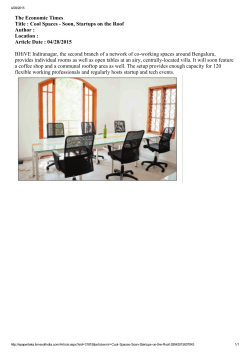
Pattern 1.7: Provide Teacher Support Spaces that Promote
DO NOT PRINT PROVIDE TEACHER SUPPORT SPACES THAT PROMOTE COLLABORATION 3.1.24 Design Principle 1: Teaching and Learning to Accommodate the Needs of All Learners Pattern 1.7: Provide Teacher Support Spaces that Promote Collaboration Best Practices Denver School of Science and Technology • At Denver School of Science and Technology, classrooms are clustered with a variety of support spaces for students and teachers. These clusters not only allow teachers to work together in the classroom but also collaborate with each other outside of the classroom, for example in the “studio” pod area. John A. Johnson • At John A. Johnson, teachers share offices located between two year level elementary classrooms. The sharing of the offices allow for teachers to discuss and aid one another with their teaching and lesson planning. High Tech High International • Another important feature of these work spaces are the interior windows as seen at High Tech High International. This allows for teachers in the space to be visible to students and also allows the teachers to keep a watchful eye on the surrounding informal learning spaces. Figure 3.1.7.1: Teacher offices at Xavier School of Excellence Charter School are clustered together for staff collaboration and are in close proximity to a teacher’s lounge, conference room, and prep room. Figure 3.1.7.2: Diagrams show teacher work room and breakout space between classrooms. Teacher support shared spaces between classrooms is a way to promote dialogue and curriculum overlap opportunities. Problem: Too often teachers are expected to know everything there is to know on a subject or situation. This expectation is unrealistic, as subjects and situations are extremely broad and without the opportunity to discuss the questions or problems with their peers could result in misinforming the students. It is important to provide teachers with support spaces in which they can collaborate with their peers. Each teacher has their individual strengths, allowing for these strengths and ideas to be discussed will allow for a sharing of the knowledge within the school community. This will also allow for interdisciplinary collaboration. In elementary school having two or more classrooms for 1st, 2nd, and 3rd graders is often the norm. When these same grade classrooms are located in such a way that teachers can share office space, the content overlap and collaboration opportunity is a huge benefit for the students. In middle and high schools having faculty offices which share curricular content in close proximity to the classroom provides easy access for students and their questions. School of Environmental Studies • At the School of Environmental Studies, also called the Zoo School, students and teachers work in “houses.” These houses allow for an open and flexible learning environment where teachers are able to easily collaborate with one another and with students. Each house is supported with science labs, an advisor’s work area, and seminar rooms. Collaborative Spaces • Through these collaboration spaces the teachers are able to create a supportive community for themselves, just as the classroom clusters have created a community for the students. This allows teachers in 10th grade teaching math, science, English, and social studies to share ideas and offer ways to form a more integrative curriculum. • The teachers also share a breakout space allowing for the teachers to work with one another’s students if need be. This can be helpful, in educating the students, as one teachers method(s) of teaching may not be as well received by certain students. Solution: Consider the design and location of teacher spaces to both support the classroom in their adjacency, and to promote shared dialogue with teachers. Teacher workstations and teacher’s lounges or break spaces should be strategically located to provide opportunities to rest and recoup and to share and inspire, allowing easy and convenient access for students. Charter School Patterns of Innovation A Building Better Communities Project PROVIDE TEACHER SUPPORT SPACES THAT PROMOTE COLLABORATION 3.1.25 Design Principle 1: Teaching and Learning to Accommodate the Needs of All Learners Design Recommendations • Provide teachers with shared offices to promote collaboration between staff. • Promote collaboration between teachers through teacher lounges, workstations, shared teaching spaces, and/or break spaces. • Create informal interaction spaces where teachers can support each other and utilize each others strengths. • Allow for the work spaces to be visible from neighboring spaces to promote collaboration, informal surveillance, and convenient access for students. • Classrooms which are flexible through furniture and/or movable walls can allow for teachers to easily collaborate with each other. Figure 3.1.7.5: By utilizing interior windows with blinds in this support space at Denver School of Science and Technology, teachers are able to see each other. This allows for impromptu collaboration between teachers who would otherwise go unnoticed. Figure 3.1.7.3: At Galileo Charter School the teacher support space is located directly off the hallway and interior windows allow for views into and out of the space. Figure 3.1.7.4: A shared teachers office at John A. Johnson allows for teachers to work together and discuss ideas as they are developing lesson plans. Figure 3.1.7.6: The teachers work area within the classroom clusters at Denver School of Science and Technology provides teachers with many resources and places to gather together and collaborate with one another. A New Architecture for a New Education Ball State University
© Copyright 2025









